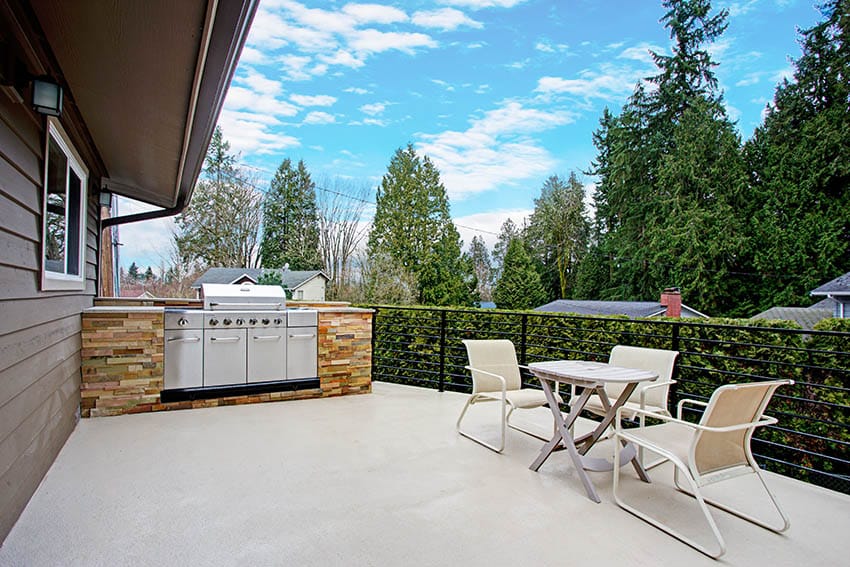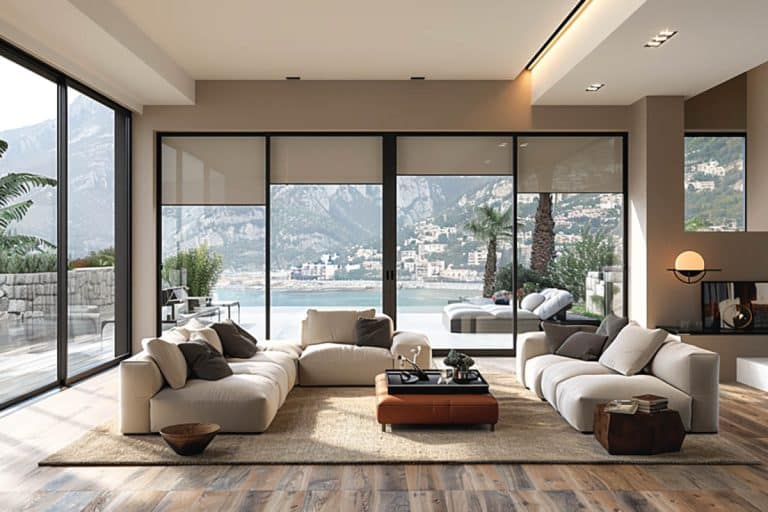Concrete Stain vs Paint (Pros and Cons)
Staining and painting are two of the most popular ways of adding color and beautifying concrete swimming pool decks, walkways, patios, and driveways. Unfortunately, most people look at these processes as the same. It cannot be farther from the truth. Knowing the unique attributes of concrete stain vs paint will help homeowners decide which option to use for their properties.

Let’s compare the two below, starting with staining.
What Is Concrete Staining?

Staining is a method of adding color and unique design to concreted surfaces, allowing the pigments to penetrate and integrate with the concrete mixture. Unlike paint that only stays on the concrete’s surface, stains become embedded into the cement, becoming an integral component of the structure.
Because the pigment penetrates the mortar mixture, it creates a translucent appearance. One can see the distinct physical characteristics of the concrete floor or wall.
Cement stains can be either water-based or acid. The former is easier to work with, requiring only the application of an appropriate sealant to prevent fading. One has to use more water-based stains to achieve a deeper color in the cement mixture.
Acid stains produce more stunning aesthetics but are challenging to apply. They can also pose a health threat, causing serious lung, eye, and skin irritation if the acid gets in contact with these body parts.
Because the pigment becomes a part of the mixture, this coloring option does not chip, flake, or peel away. Of course, cracks in the cement also reduce the stain’s elegant look.
What Is Concrete Paint?

Many people believe that painting cement is a lot more straightforward than staining. While this may be true, cement painting requires prep work to ensure the proper adhesion of pigment molecules on the concrete’s surface.
Compared with staining, painting only coats a structure’s surface. It does not penetrate, blend, or integrate with the cement mix.
That is why cement paint creates an opaque surface suitable for hiding or masking surface imperfections. This painted layer also forms a protective shield for the cement against heat, cold, and other environmental forces.
The only issue is that paint can peel off, flake, or chip if applied wrongly. Inadequate or incorrect surface preparation can also contribute to the occurrence of these issues.
Painted cement can also look stunning, depending on what homeowners want and the installer’s creativity and skill level.
Pros and Cons of Concrete Stain

- Improves the floor’s aesthetic value by adding attention-grabbing waves, swirls, stenciled designs, marbling, and other visual effects
- Ideal for outdoor patios and indoor decorative floors
- Does not chip, flake, or peel away, making it more durable
- Compatible with other floor finishes, such as clear urethane coating and polish
Cons
- Has no impact on cement’s strength and durability
- Translucent appearance can reveal imperfections in the cemented floor
- Acid stain requires professional installation with special tools and techniques for safety
Pros and Cons of Concrete Paint

- Adds stunning colors to concreted structures, depending on the painter’s skill and creativity
- Ideal for hiding surface imperfections, including cracks and stains
- It can protect the cement against temperature extremes and other environmental factors
- Recommended for spill-proofing the floor
Cons
- Expert application is recommended because of the number of required prep work
- Tends to peel or chip when not applied correctly
Is It Better to Paint or Stain On Concrete?
Choosing between painted and stained cement is a matter of personal preference. Both design methods can improve a structure’s aesthetic appearance.
However, staining often provides a more elegant and more polished concrete look because of its translucent nature.
Stain, unlike paint, penetrates the surface of the cement and is generally lower maintenance and lasts longer. Coating the stain with a sealer is the ideal way to ensure it remains looking good and protects against water, chemicals and oil.
Painted cement can look stunning, too, especially with a clear topcoat to give it a distinct sheen.
However, the main advantage of cement paint is its ability to mask surface imperfections, including cracks and stains. Homeowners with surface imperfections on their floors and other structures would do well to apply paint.
Another option to consider is an epoxy patio design which offers some advantages when compared to paint.
Which Lasts Longer: Stained Concrete or Painted?
If people only talk about the pigments used in staining or painting cement, stains often come out on top. One must remember the difference in application methods.
Painted cement only requires the application of the pigment on the concrete’s surface. Its superficial nature leaves it prone to peeling, flaking, or chipping.
That is why cement painting requires plenty of preparatory work to minimize such issues and ensure a more permanent paint-to-surface adhesion.
Typically cement coat used outdoors last about 3 to 5 years before needing a new coat of paint. The coat will last longer if it is in a covered area or not exposed to the weather.
On the other hand, because staining involves the addition of pigments into the cement mix, the stain becomes an integral part of the cement. It does not stay on the surface, but rather deep in the cement.
Stained cement never chips, peels, or flakes. Cement stains can last up to 100 years with regular resealing and maintenance. However, it tends to fade over time. Buy a UV stable stain to ensure the color remains consistent, especially in areas that receive full sun exposure.
Is It Best to Paint or Stain a Concrete Patio?
Deciding whether to paint or stain a cemented patio boils down to what the homeowner wants. For example, if you require surface protection from damage to your cemented patio, painting it will be ideal.
The extra coat adds a layer of protection against scratches and spills. If one has cracks, crevices, or stains on the cemented patio, painting over it can hide these imperfections.
However, if one needs a patio that looks as stunning as the indoor floors of posh establishments, staining is a better option. The pigment molecules interact with cemented compounds, allowing them to bind with these substances to create a more elegant look.
Can You Paint Over the Concrete Stain?
One issue with stained cement is that it can look dull over time. If this happens, homeowners can always apply a fresh coat of coat. One must remember that paints produce an opaque layer on any surface, hiding anything underneath.
However, one must prepare the surface before painting to ensure the correct pigment adhesion and avoid chipping, flaking, or peeling. Paint molecules must have a rough surface to cling on. Otherwise, they will not bond well onto the surface.
Conclusion
Deciding on the cement stain vs. paint debate boils down to personal preferences, with both methods having their respective pros and cons.
Homeowners who wish to improve their home’s cement aesthetics must weigh their options. If not, they can always consult with a professional to determine the best possible solution to their queries.
For more content similar to this, visit our page about wood deck paint vs stain.






